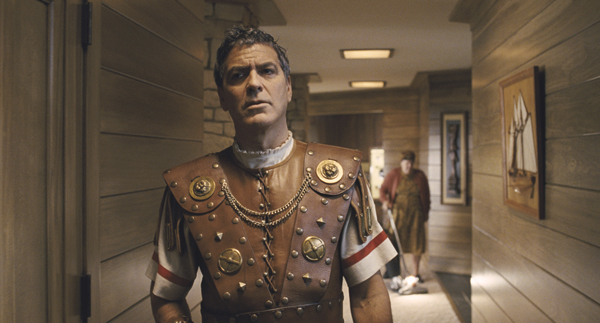Hail, Caesar! is a big, luscious, gorgeous ode to the Golden Age of Hollywood—a certain kind of Hollywood, at any rate. It’s a work that is great and minor at the same time. It has a passable central plot while everything else around it, all of the moving parts, is wonderful and hysterically funny and often perfectly timed (time being a theme here, by the way). If the parts are greater than the whole, it still has such awe-inspiring parts.
Of course, a lot of it should be taken tongue-in-cheek, but there are some themes underlying the story that are serious enough to get invested in the characters. Or, I should say Eddie Mannix (Josh Brolin), inspired by the real-life MGM executive (played in 2006’s Hollywoodland by Bob Hoskins), who runs the production arm of Capital Pictures, circa the late 1940s. Multiple film shoots are going on the studio lot, including the prestige picture of the movie’s title (subtitled “A Tale of the Christ”), an obvious wink and nod to Ben-Hur. It stars Baird Whitlock (George Clooney) hamming it up as a Roman soldier who encounters Christ. A bit of trivia: Capital Pictures is the same (fictional) studio in the Coens’ much darker Hollywood satire Barton Fink.
Whitlock gets drugged by two extras on his film’s set and taken away and brought to an underground group (operating in a Malibu beach house). As it turns out, the kidnappers are Communists who try (and sort of succeed, in a way) to indoctrinate Whitlock into their world. Other Capitol productions go on, such as a mermaid musical à la Esther Williams (with Scarlett Johansson) and a cowboy picture. But in almost the blink of an eye, the star of the oater, Hobie Doyle (Alden Ehrenreich), gets cast in a high-class drawing room comedy directed by the fussily precise Laurence Larentz (Ralph Fiennes). On another soundstage, a musical features singing and dancing sailors led by Channing Tatum. Indeed, the movie sort of functions as two stories, one with Whitlock and the other centered on the problem-solving Mannix having to go around from one set to another as the Man in Charge spinning a dozen different plates. Brolin plays Mannix with total conviction and never slips into a caricature, which is easy enough to do here.
And let’s not forget, oh, it’s impossible to do so, Tilda Swinton as a pair of twins, both competing gossip columnists with only slightly varying agendas, and Frances McDormand in a cameo as a chain-smoking film editor. Probably the sequence with Johansson comes close to being too long, but it’s still a gorgeous, over-the-top spectacle—same with Tatum’s Gene Kelly-esque musical number. We also, very thankfully, get to see some dailies from the films-within-the-film that are authentic looking and yet have an off-kilter spin. In fact, the whole movie, when it’s at its best, is like condensing a week’s worth of Turner Classic Movies programming, both the B movies and the prestige A-level stuff, into 106 minutes, with Tatum’s dance number as a mini-masterpiece, a rich satire, and a legitimately fantastic and spectacular number.
I enjoyed those parts so much that it pains me not to find the movie as one of the directors’ best. It may be seeing it a first time and having certain expectations (the trailer, one of the best in recent memory, raises expectations). Even when the movie gets very, very strange (the climax is among the strangest things the Coens have ever written and shot), it’s still highly entertaining, and the actors are having a blast, including those who just appear in a scene or two (looking at you Jonah Hill, Clancy Brown, and—yes, oh my God—that’s Christopher Lambert!).
The filmmakers lovingly re-create the period to every small detail, from the art design to Roger Deakins’s cinematography (a contrast to last year’s Sicario by light years). The directing team fills the frames with sunny, light comedy with the occasional noirish undertone. It’s as though the Coens are saying, “Yeah, this was all pretty goofy, but wasn’t it something to behold.

















Leave A Comment